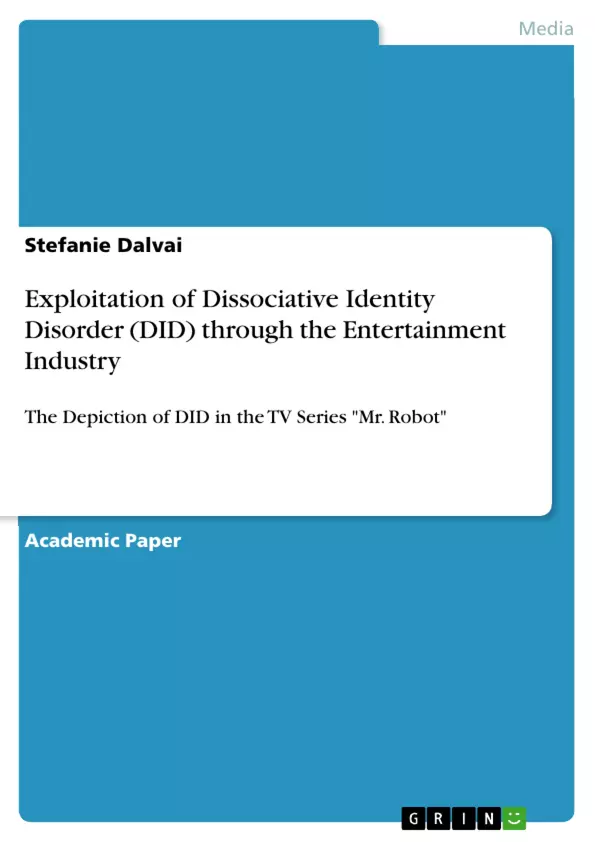The present work analyzes the exploitation of dissociative identity disorder (DID) through the entertainment industry, with a special focus on the depiction of DID in the TV series "Mr. Robot".
Human mankind is known to be easy to bribe, but the impact these corrupt actions have on people are almost always blinded out. This also happens in the film industry where topics get exploited and distorted to make them as interesting as possible. In the end, little remains of the truth, but the spectator often does not know that and takes what is shown on screen as reality. This has also happened to a disease called "dissociative identity disorder". A high percentage of people are not even aware of this disease, and when they see it in movies or series they either believe it to be fantasy or they stick to the depiction given by the film, without even going further into the topic. As the depiction of the afflicted people is often one of a crazy, uncontrollable or ridiculous split personality, like in Robert Louis Stevenson’s novella "The Strange Case of Dr. Jekyll and Mr. Hyde", dating back to 1886, and in movies like "Psycho", "Fight Club", "Me myself and Irene" and many more, it can have a huge negative impact on people with DID.
To undo these movies which have already been created is impossible, but we still have the present to change people’s minds and lives. Therefore, it is important to examine everything that appears on television about this topic, and as "Mr. Robot" is a fairly new series and a third season will be aired in future, the question arises if this series too has been exploiting and distorting DID for the sake of entertainment; hence, this is the question this paper is aimed to answer. In order to properly analyze "Mr. Robot", first a detailed definition of dissociative identity disorder will be given to understand what DID is really all about. Secondly, an examination about two fairly recent examples of the exploitation of DID will follow to make sure the reader of this paper understands how reckless the filming industry can sometimes be. The last chapter will exclusively be about the series "Mr. Robot" and its depiction of dissociative identity disorder, following the topic question.
Inhaltsverzeichnis (Table of Contents)
- Introduction
- DID: Definition, causes and therapy
- DID in movies
- United States of Tara
- Split
- DID in Mr. Robot
- Elliot Alderson' personality
- Symptoms
- Origin of DID
- The switch
- The alters
- Therapy
- Conclusion
Zielsetzung und Themenschwerpunkte (Objectives and Key Themes)
This paper examines the portrayal of dissociative identity disorder (DID) in the television series Mr. Robot and assesses whether the series accurately reflects the reality of DID. The paper aims to raise awareness about the potential exploitation and distortion of mental illness in the entertainment industry.
- The definition and characteristics of dissociative identity disorder (DID)
- The history of the portrayal of DID in movies and television series
- The portrayal of DID in Mr. Robot, including the main character's personality, symptoms, and therapy
- The potential impact of inaccurate or exploitative depictions of DID on viewers
- The importance of responsible and accurate portrayal of mental illness in media.
Zusammenfassung der Kapitel (Chapter Summaries)
- Introduction: This chapter introduces the topic of DID in film and television and discusses how the entertainment industry often exploits and distorts mental illness for entertainment purposes. It highlights the need for accurate representations and explores the potential impact of inaccurate portrayals on viewers, especially those with DID.
- DID: Definition, causes and therapy: This chapter provides a detailed definition of dissociative identity disorder, outlining its symptoms, causes, and treatment. It also discusses the challenges in diagnosing and treating DID, emphasizing its complexity and the potential for misinterpretation.
- DID in movies: This chapter examines two recent examples of films that have depicted DID: "United States of Tara" and "Split." It analyzes the portrayal of DID in these films, highlighting both their strengths and weaknesses in depicting the disorder.
Schlüsselwörter (Keywords)
This paper focuses on dissociative identity disorder (DID), its portrayal in the entertainment industry, and its specific depiction in the television series Mr. Robot. Key topics include the definition and symptoms of DID, the history of its portrayal in film and television, the impact of inaccurate portrayals, and the importance of responsible representation of mental illness in media.
- Quote paper
- Stefanie Dalvai (Author), 2017, Exploitation of Dissociative Identity Disorder (DID) through the Entertainment Industry, Munich, GRIN Verlag, https://www.grin.com/document/456408



